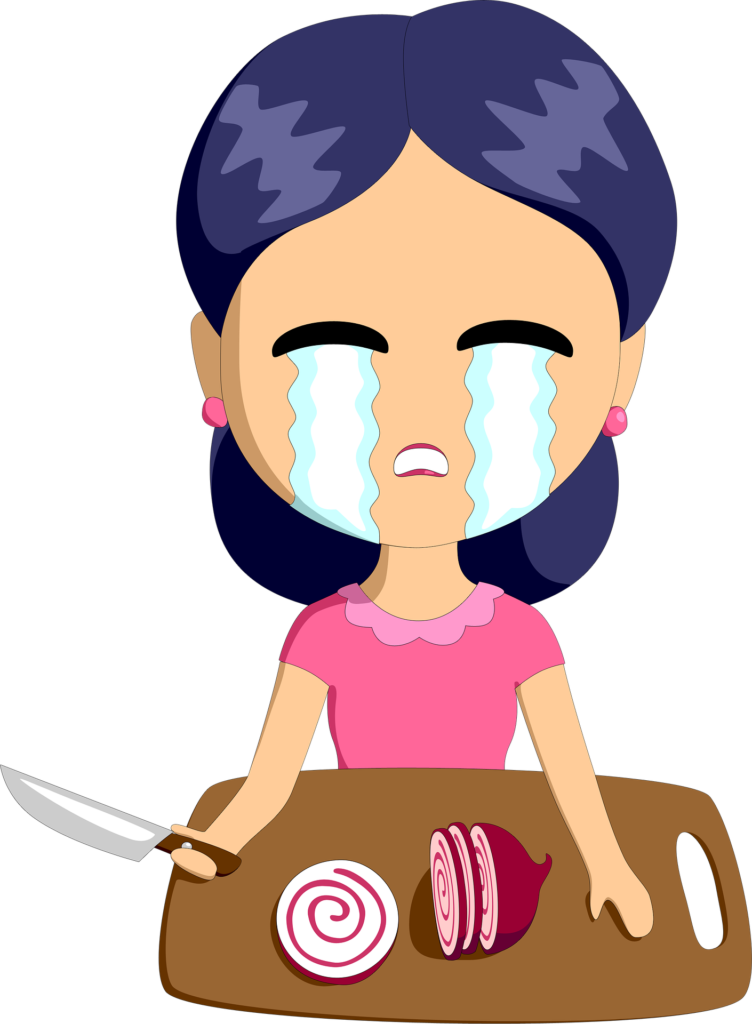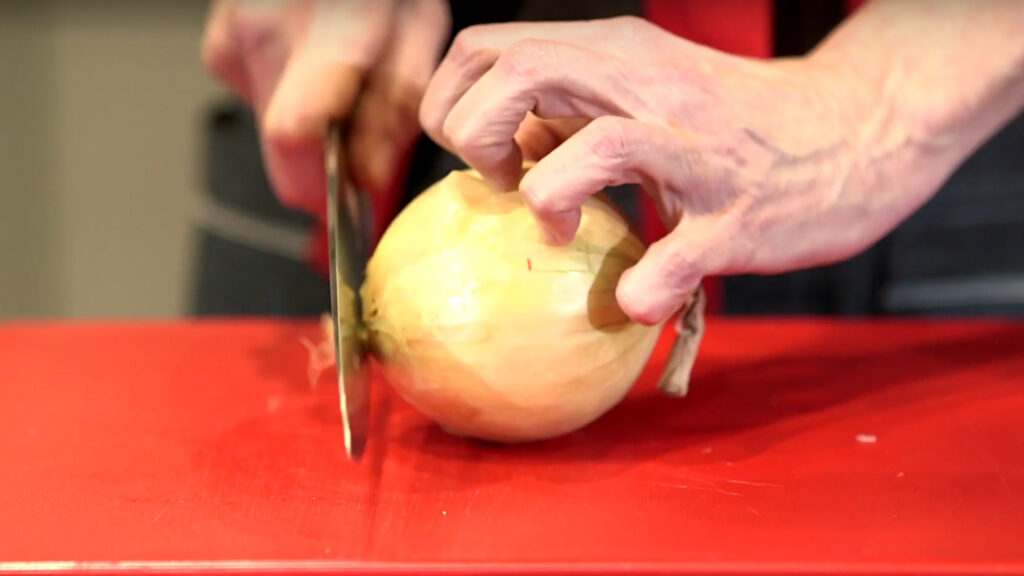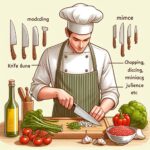Cutting an onion without crying can be challenging, but here are several methods that can help minimize tears:
- Chill the Onion: Place the onion in the refrigerator for 30 minutes or in the freezer for 10-15 minutes.
- Use a Sharp Knife: Ensure your knife is sharp to reduce cell damage and the release of irritants.
- Cut Off the Top: Slice off the top of the onion, leaving the root end intact.
- Peel the Onion: Remove the outer skin of the onion.
- Cut Under Water: Slice the onion under running water or in a bowl of water.
- Ventilate the Area: Cut the onion near an open window or use a fan to blow fumes away.
- Light a Candle: Light a candle nearby to help burn off sulfur compounds.
- Wear Goggles: Put on kitchen or swimming goggles to protect your eyes.
- Soak the Onion: Soak the peeled onion in water for 10 minutes before cutting.
- Breathe Through Your Mouth: Breathe through your mouth and stick your tongue out slightly to draw fumes away from your eyes
Chopping onions is a common kitchen task that often ends in a tearful experience. The irritation to the eyes comes from the enzymes released when an onion’s cell wall is broken. Tackling this challenge can make cooking a more pleasant experience. To know more about how to cut an onion without crying, let’s read in!
Pre-cutting Preparations To Minimize Tears
Various methods are suggested to help reduce tears, such as cutting under a vent or wearing goggles, but not all are convenient or effective. The key lies in understanding the chemistry of onions and how to disrupt it with minimal fuss. This introduction offers a brief guide on how to avoid tears while engaging in this everyday kitchen activity. Whether you’re a home cook or a professional chef, mastering the art of tear-free onion cutting can be a simple yet significant kitchen skill.

Tearing up while chopping onions is a common kitchen annoyance, but it can be avoided with some savvy preparations. Before diving knife-first into that bulbous allium, taking the proper steps can mean the difference between tearful frustration and a tear-free chopping experience. Below, explore the essential pre-cutting strategies designed to keep those pesky tears at bay.
Selecting The Right Onion To Reduce Tears
Not all onions are created equal, especially when it comes to their tear-inducing potential. Opt for ‘sweet’ onion varieties like Vidalias or Walla Wallas, which tend to have a lower sulfur content, and thus, less likely to cause irritation. The fresher the onion, the better, as aging onions can develop a higher concentration of the chemicals that lead to tears.
Chilling Techniques Before Cutting
One effective tactic is to chill onions prior to cutting. Simply place the onions in your freezer for about 15 minutes before cutting. The cold temperature helps to reduce the release of the eye-irritating enzymes, making the dicing process significantly more comfortable.
Why A Sharp Knife Matters
Ever wondered why a sharp knife could be your ally against onion tears? A dull knife will crush the onion cells, spewing more irritants into the air. In contrast, a razor-sharp blade offers a clean cut, minimizing the release of noxious chemicals. Maintain a well-honed knife for a smoother, tear-free chopping experience.
Preventing Irritation Through Appropriate Cutting Surfaces
- Wooden cutting boards – Their porous nature can help absorb some of the onion’s volatile compounds.
- Plastic cutting boards – Non-porous and easy to clean, they prevent the absorption of odors.
However, avoid using glass or stone cutting surfaces as they can dull your knife, requiring more force while cutting, thus releasing more tear-triggering chemicals into the air. Choose your cutting surface wisely to further reduce the likelihood of tears.
Best Tips On How to Cut an Onion Without Crying

Chopping onions is an inevitable and tearjerking part of cooking. But fear not, because tear-free onion-cutting techniques are here to save your eyes from irritation. In this section, discover the secrets behind keeping your eyes dry while cutting onions. Implement these methods and say goodbye to the days of weepy onion preparation!
Cutting Methods That Limit Exposure To Irritants
The compounds in onions responsible for causing tears are released upon cutting. By minimizing the exposure to these irritants, you can greatly reduce the likelihood of crying.
- Use a sharp knife: A sharp blade causes less damage to onion cells, releasing fewer irritants.
- Leave the root intact: The root contains a higher concentration of irritating compounds, so cut the onion all around without slicing off the root until the end.
- Chill the onions: Refrigerate onions for 30 minutes before chopping to reduce the volatility of the irritating substances.
Use Of Water To Reduce Airborne Compounds
Water can act as a barrier between your eyes and the sulfenic acids that onions release. Here are several ways to incorporate water into your onion-cutting routine:
- Soak the onion: Peel and then soak the onion in water for several minutes before chopping.
- Cut under running water: Tricky but effective; cut the onion under a small stream of water to immediately wash away irritants.
- Use a fan: Set up a small fan on your kitchen counter to blow the onion fumes away from your face.
Onion-cutting Gadgets And Tools
There’s nothing wrong with seeking a little technological help when it comes to prepping your onions. Check out these handy tools to make the task easier:
| Gadget | Function |
|---|---|
| Onion goggles: | Protect your eyes from irritants with a pair of sealed kitchen goggles. |
| Onion chopper: | These enclosed devices keep irritants contained while dicing your onion. |
| Mandoline slicer: | Quickly slice through onions while keeping your face at a safe distance. |
Professional Chefs’ Tips And Tricks For Tearless Onion Chopping
Professional chefs often have their own arsenal of techniques for onion-chopping without shedding a tear. Here are some tried-and-true methods: Breathe through your mouth: Use your tongue to draw the irritants away from your nose and eyes. Chew gum: Chewing can encourage you to breathe through your mouth, diverting fumes away. Cut near a hot surface: Onion fumes rise, so cutting onions near a hot stove might allow the irritants to dissipate faster.
Alternative Methods To Avoid Onion Tears
Cutting onions is often a tearful affair, but it doesn’t have to be. I’ll guide you through various tear-free alternatives for chopping onions that keep the sting away from your eyes. Dive into these tips and tricks and say goodbye to crying over your cutting board!
Ventilation And How It Helps
A stream of fresh air can work wonders when it comes to combating onion tears. Here’s why:
- Fresh air disperses onion vapors.
- A well-ventilated area minimizes the concentration of onion enzymes near your eyes.
- Having a fan or open window allows these irritants to dissipate quickly.
Tip: Position a small fan on the counter to blow air away from you while chopping.
Protective Gear That Can Shield Eyes

Don protective eyewear to shield your eyes from onion vapors:
| Method | Description | Effectiveness |
|---|---|---|
| Goggles | Onion goggles provide a seal around your eyes. | High |
| Swimming Goggles | Tight-fitting and easily available at home. | Medium |
| Glasses | Regular eyeglasses offer minimal protection. | Low |
Keep in mind: Proper fit is crucial for effective protection.
Food Processing Alternatives For Onion Preparation
Use kitchen gadgets to minimize exposure to onion vapors:
- Food Processor: Fast and efficient; it can chop onions in seconds.
- Mandolin Slicer: Quick slices with less hands-on contact.
- Manual Choppers: Enclosed devices that contain vapors as they chop.
Result: Less time spent cutting means fewer tears.
Natural Remedies And Folk Solutions
Old wives’ tales or not, these natural methods might just do the trick: Chilled Onions Refrigerate onions to slow down the release of enzymes. Bread in Mouth Hold a piece of bread between your teeth to absorb irritants before they reach your eyes. Sharp Knives A sharp blade causes less cell damage, reducing irritants.
These time-tested techniques could save you from shedding a single tear.
After-cutting Best Practices And Clean-up
Successfully slicing an onion without tears is cause for celebration—but the battle isn’t over yet. Proper after-cutting practices and clean-up are essential to avoid prolonged onion-induced discomfort. Follow these simple yet crucial steps to ensure the lingering effects of onion odors and irritation don’t stick around longer than your meal.
Handling Onion Waste To Avoid Residual Irritation
Once the onion is chopped, prompt disposal of the scraps is key. Avoid touching your face or eyes after handling onion waste as the potent chemicals can still cause irritation.
- Place the onion peels and ends directly into a compost bin or securely tied garbage bag.
- Rinse the chopping board immediately to prevent juices from drying out.
- For those with sensitive skin, consider wearing gloves during disposal.
Washing And Storing Utensils To Prevent Lingering Smells
Onion odors can cling to your knives and cutting boards if not washed properly. Use hot, soapy water to scrub your utensils thoroughly.
- Soak knives and cutting boards for a few minutes.
- Scrub with a brush to remove any residue.
- Rinse under hot running water.
- Dry completely before storing to prevent bacteria growth.
Eye Care Post Onion Cutting
If your eyes feel irritated after cutting onions, flush them with cool water. Avoid rubbing as this can worsen the discomfort.
- Use a soothing eye wash or saline solution if available.
- Consider using preservative-free lubricating eye drops to alleviate any persistent irritation.
Deodorizing The Kitchen After Cooking With Onions
Aromatic as they are, onions leave a strong scent that permeates the kitchen. Neutralize the odor with these tips:
| Method | Instructions |
|---|---|
| Vinegar Bowl | Place a bowl of white vinegar on the counter to absorb odors. |
| Lemon Steam | Simmer a pot of water with lemon slices to freshen the air. |
| Baking Soda | Sprinkle baking soda in trash bins and on surfaces, then wipe after a few minutes. |
Remember, these after-cutting practices not only contribute to a pleasant cooking environment but also help maintain hygiene in your kitchen. Keep tears in the past, and savor the triumph of tear-free onion chopping!

Summary
Chopping onions no longer has to end in tears. By using the right tools and techniques, such as a sharp knife, chilling the onions, and employing the water method, you can dice away without the usual discomfort. Remember, practice makes perfect, and with these handy tips, you’ll be a tear-free onion-chopping expert in no time.
Keep slicing, stay tearless, and enjoy the flavor onions add to your dishes!







